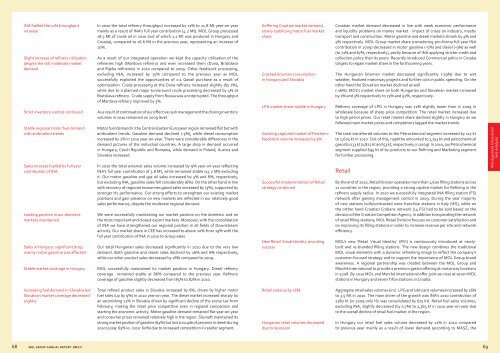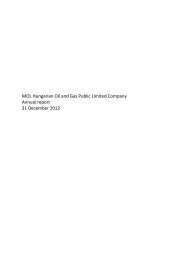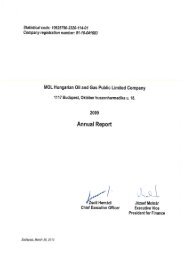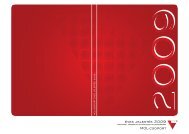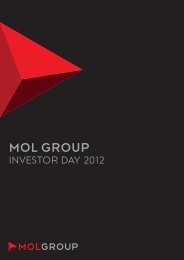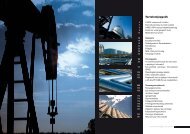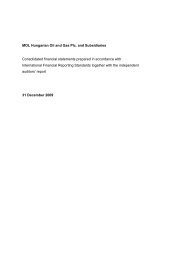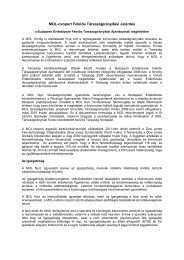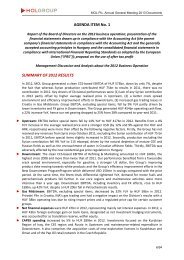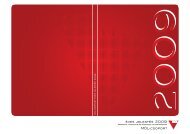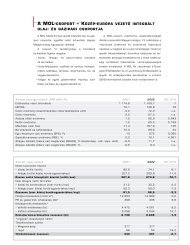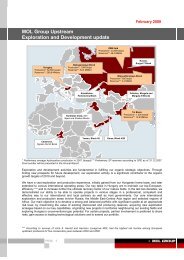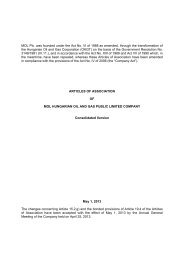MOL GROUP Annual Report
MOL GROUP Annual Report
MOL GROUP Annual Report
- No tags were found...
You also want an ePaper? Increase the reach of your titles
YUMPU automatically turns print PDFs into web optimized ePapers that Google loves.
INA fuelled the 11% throughputincreaseSlight increase of refinery utilisationdespite the still moderate marketdemandStrict inventory control continuedStable regional motor fuel demandwith ambivalent trendsSales increase fuelled by full yearcontribution of INALeading position in our domesticmarkets maintainedSales in Hungary: significant drop,mainly motor gasoline was affectedStable market coverage in HungaryIn 2010 the total refinery throughput increased by 11% to 21.8 Mt year-on-yearmainly as a result of INA’s full year contribution (4.2 Mt). <strong>MOL</strong> Group processed18.3 Mt of crude oil in 2010 (out of which 1.1 Mt was produced in Hungary andCroatia), compared to 16.6 Mt in the previous year, representing an increase of10%.As a result of our integrated operation we kept the capacity utilisation of therefineries high (Mantova refinery) and even increased them (Duna, Bratislavaand Rijeka refineries) in 2010 compared to 2009. Other feedstock processing,excluding INA, increased by 15% compared to the previous year as <strong>MOL</strong>successfully exploited the opportunities of 0.1 Gasoil purchase as a result ofoptimization. Crude processing at the Duna refinery increased slightly (by 1%),while due to a planned major turnaround crude processing decreased by 4% atBratislava refinery. Crude supply from Russia was uninterrupted. The throughputof Mantova refinery improved by 3%.As a result of continuation of our effective cash management the closing inventoryvolumes in 2010 remained on 2009 level.Motor fuel demand in the Central-Eastern European region remained flat but withambivalent trends. Gasoline demand declined (-5%), while diesel consumptionincreased by 2% in 2010 year-on-year. There were considerable differences in thedemand pictures of the individual countries. A large drop in demand occurredin Hungary, Czech Republic and Romania, while demand in Poland, Austria andSlovakia increased.In 2010 the total external sales volume increased by 9% year-on-year reflectingINA’s full year contribution of 3.8 Mt, while remained stable (15.2 Mt) excludingit. Our motor gasoline and gas oil sales increased by 5% and 8%, respectively,but excluding INA, gasoline sales fell considerably (6%). On the other hand in linewith recovery of regional economies gasoil sales increased by (3%), supported bystronger H2 performance. Our strong efforts to strenghten our existing marketpositions and gain presence on new markets are reflected in our relatively goodsales performance, despite the moderate regional demand.We were successfully maintaining our market position on the domestic and onthe most important and closest export markets. Moreover, with the consolidationof INA we have strengthened our regional position in all fields of Downstreamactivity. Our market share in CEE has increased to above 20% from 19% with thefull year contribution of INA in 2010 to Group sales.Our total Hungarian sales decreased significantly in 2010 due to the very lowdemand. Both gasoline and diesel sales declined by 16% and 6% respectively,while our other product sales decreased by 18% compared to 2009.<strong>MOL</strong> successfully maintained its market position in Hungary. Diesel refinerycoverage remained stable at 86% compared to the previous year. Refinerycoverage of gasoline slightly decreased from 85% to 82% in 2010.Suffering Croatian market demand,slowly stabilizing motor fuel marketshareCrashed bitumen consumptionin Hungary and SlovakiaLPG market share: stable in HungaryGrowing captured market of Petchem:feedstock volume increased by 5%Successful implementation of Retailstrategy continuedNew Retail Visual Identity providingsuccessCroatian market demand decreased in line with weak economic performanceand liquidity problems on money market - impact of crises on industry, mostlytransport and construction. Motor gasoline and diesel markets shrank by 4% and5% respectively. <strong>MOL</strong> Group market share (considering pro-forma full year INAcontribution in 2009) decreased in motor gasoline (-5%) and diesel (-9%) as well(to 71% and 67%, respectively), partly because of INA applying stricter credit andcollection policy than its peers. Recently inroduced Commercial policy in Croatiatargets to regain market share in the forthcoming years.The Hungarian bitumen market decreased significantly (-29%) due to wetweather, finalized motorway projects and further cuts in public spending. On theother hand the Slovakian market declined as well(-16%). <strong>MOL</strong>’s market share on both Hungarian and Slovakian market increasedby 1% and 3% respectively to 73% and 52%, respectively.Refinery coverage of LPG in Hungary was 72% slightly lower than in 2009 inwholesale because of sharp price competition. The retail market increased dueto high petrol prices. Our retail market share declined slightly in Hungary as wefollowed main market prices and competitors lagged the market trends.The total transferred volumes to the Petrochemical segment increased by 117 ktto 2,605 kt in 2010. Out of this, naphtha amounted to 1,753 kt and petrochemicalgasoil to 233 kt (1,822 kt and 53 kt, respectively, in 2009). In 2010, our Petrochemicalsegment supplied 695 kt of by-products to our Refining and Marketing segmentfor further processing.RetailBy the end of 2010, Retail Divison operates more than 1,600 filling stations across11 countries in the region, providing a strong captive market for Refining in therefinery supply radius. In 2010 we successfully integrated INA filling station (FS)network after gaining management control in 2009. During the year majorityof new stations built/contracted were franchise stations in Italy (IES), while onthe orther hand Croatian Crobenz network (14 FS) had to be sold based on thedecision of the Croatian Competiton Agency. In addition to expanding the networkof retail filling stations, <strong>MOL</strong> Retail Division focuses on customer satisfaction andon improving its filling stations in order to increase revenue per site and networkefficiency.<strong>MOL</strong>’s new ‘Retail Visual Identity’ (RVI) is continuously introduced at newlybuiltand re-branded filling stations. The new design combines the traditional<strong>MOL</strong> visual elements with a dynamic refreshing image to reflect the company’scustomer-focused strategy and to support the importance of <strong>MOL</strong> Group brandawareness. A regional partnership was created between the <strong>MOL</strong> Group andMarché International to provide a premium gastro offering at motorway locationsin 2008. By 2010 <strong>MOL</strong> and Marché International offer joint services at seven <strong>MOL</strong>stations in Hungary and seven Tifon stations in Croatia.Management Discussionand AnalysisIncreasing fuel demand in Slovakia butSlovakian market coverage decreasedslightlyTotal refined product sales in Slovakia increased by 6%, driven by higher motorfuel sales (up by 9%) in 2010 year-on-year. The diesel market increased sharply byan astonishing 21% in Slovakia driven by significant decline of the excise tax fromFebruary, making the retail price competitive even in regional comparison andstarting the economic activity. Motor gasoline demand remained flat year-on-yearand consumer prices remained relatively high in the region. Slovnaft maintained itsstrong market position of gasoline (64%) but lost a couple of percents in diesel during2010 (2009: 63% vs. 2010: 60%) due to increased competition in reseller segment.Retail sales up by 16%Hungarian retail volumes decreaseddue to recessionAggregate retail sales volumes (incl. LPG and lubricant volumes) increased by 16%to 3.5 Mt in 2010. The main driver of the growth was INA’s 2010 contribution of1180 kt (in 2009 only H2 was consolidated by 675 kt). Retail fuel sales volumes,excluding INA, slightly decreased (by 0.7%) to 2,365 kt in 2010 year-on-year dueto the overall decline of retail fuel market in the region.In Hungary our retail fuel sales volume decreased by 11% in 2010 comparedto previous year mainly as a result of lower demand (according to MÁSZ, the68 <strong>MOL</strong> Group ANnual <strong>Report</strong> 2010 69


